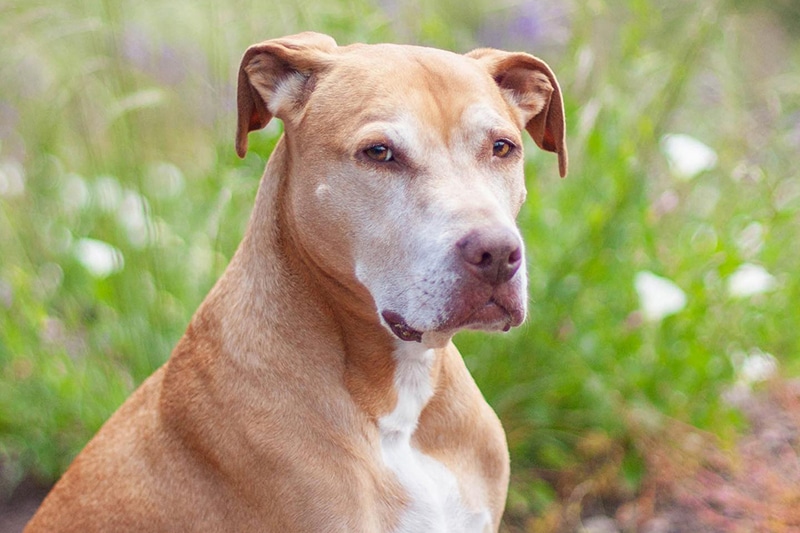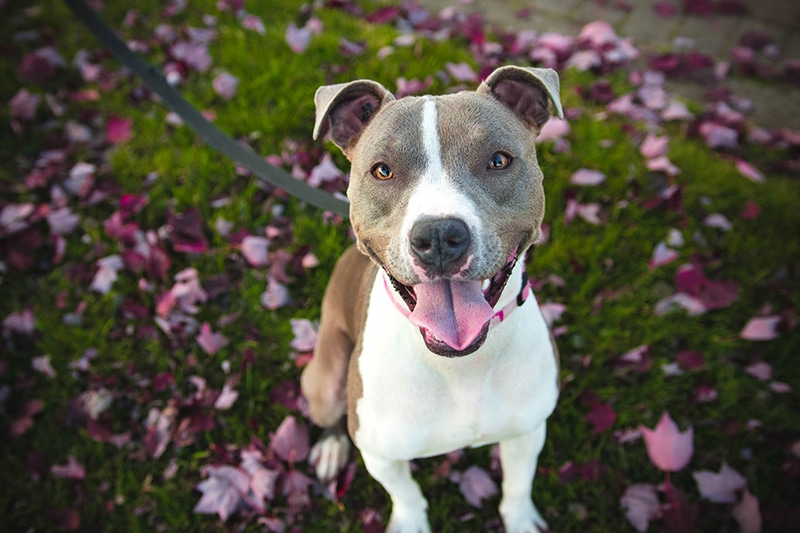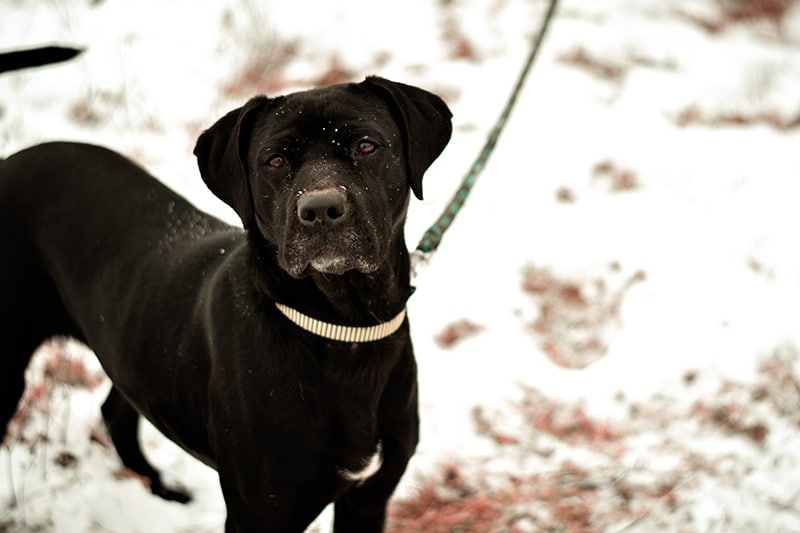The Pomeranian Pitbull mix combines two small dogs with wildly different temperaments. Despite being a rare crossbreed, the result could be either a spry, energetic, lively pup – like the Pitbull – or a more laid-back and lovable lapdog, like the Pomeranian.

Pomeranian Pitbull Mix – At a Glance
| Weight: | 7 – 24 pounds |
| Height: | 8 – 18 inches |
| Lifespan: | 12 – 16 years |
| Coat Colors: | brindle, white & black/blue/red, spotted |
| Temperament: | Energetic, gentle, protective, friendly |
| Most Suitable For: | Couples without children, single individuals |
What Does a Pomeranian Pitbull Mix Look Like?

Like all designer dog breeds, the Pomeranian Pitbull mix will borrow much of its physical appearance from both its parent breeds, so you may find yourself staring at something that approximates the physical appearance of both the Pomeranian and the Pitbull.
You’ll likely see that your Pomeranian Pitbull mix has a sturdy body shape and is well-built, like its Pitbull parent, though its face shape may resemble a fox-like the Pomeranian – or be more blunt, like the Pitbull. You can expect a short tail and an elongated body. You can also expect your Pomeranian Pitbull mix to have thick, short fur.
Are you looking for a way to treat your furry friend? Sign up for our newsletter for a chance to win a free month of Barkbox!
The History of the Pomeranian Pitbull Mix
As a designer dog breed, there is little available history concerning the Pomeranian Pitbull mix. Though we know that most crossbreeds first became prominent in the United States during the 1990s and early 2000s, crossbreeding was first popularized in the 1960s.
It stands to reason that the Pomeranian Pitbull was first crossed during this period.
The History of the Pomeranian
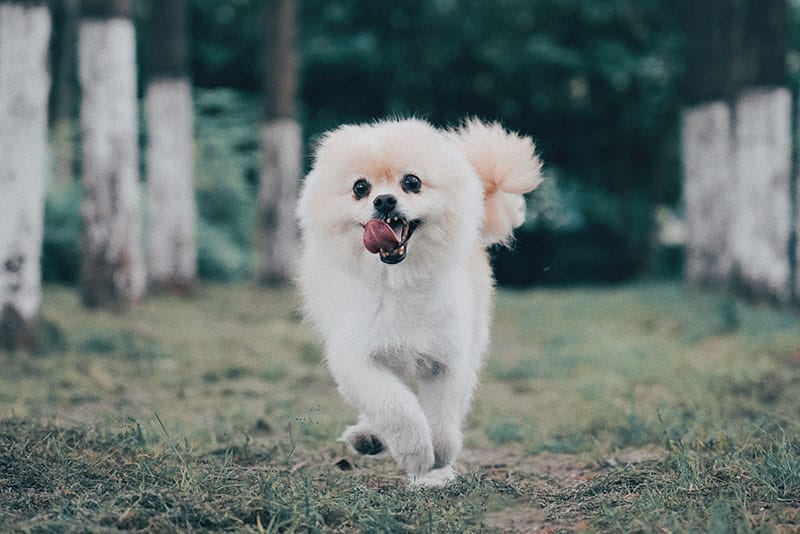
The Pomeranian is one of those dogs with some of the oldest heritage in the world, dating back to the ancient Spitz dogs of Lapland (Poland) and Germany. Pomeranians hail from the Pomerania region of Germany/Poland – the area lies on the Baltic Sea and is split between the two nations.
Pomeranians sort of look like miniature foxes due to their Spitz heritage, and were first popularized in England in 1767, after Queen Charlotte (Queen Consort of King George III) brought her two Pomeranians to England upon their marriage.
Since then, Pomeranians have been favourite royal dogs – perhaps second-only to the Welsh Corgi – and have made their way faithfully into hearts and homes around the West as even-tempered, energetic lapdogs.
How Popular Are Pomeranians in the United States?
Pomeranians were first registered with the American Kennel Club in 1898. However, there’s no information about when they first arrived in the country – though we can surmise they came with their emigrant owners from Britain.
Pomeranians are modestly popular dogs in the United States, ranking 34th in the 2021 most-popular rankings as curated by the American Kennel Club.
Who Are Pomeranians a Good Dog For?
Given their relatively small size and low-maintenance personality, Pomeranians make fantastic dogs for just about anyone. They’re an excellent option for an older person seeking a companion pet and being wonderful companions for families with children and couples.
How Did Pomeranians Come About?
Pomeranians are descended from the ancient German Spitz dogs but first became prominent in England in the late 18th century, as they were brought to the British Isles by Queen Charlotte – Queen-Consort to then-King George III – and grandmother of Queen Victoria.
When Did We First Cross-Breed The Pomeranian?
Crossbreeding of Pomeranians has been happening for about 30 or 40 years – though documentation of when the first Pomeranian was crossbred doesn’t exist – we do know that Pomeranians are very popular crosses today.
Crossbreeding of Pomeranians with other dogs is very popular, mostly due to their size and relative easy-going nature.
The History of the Pitbull
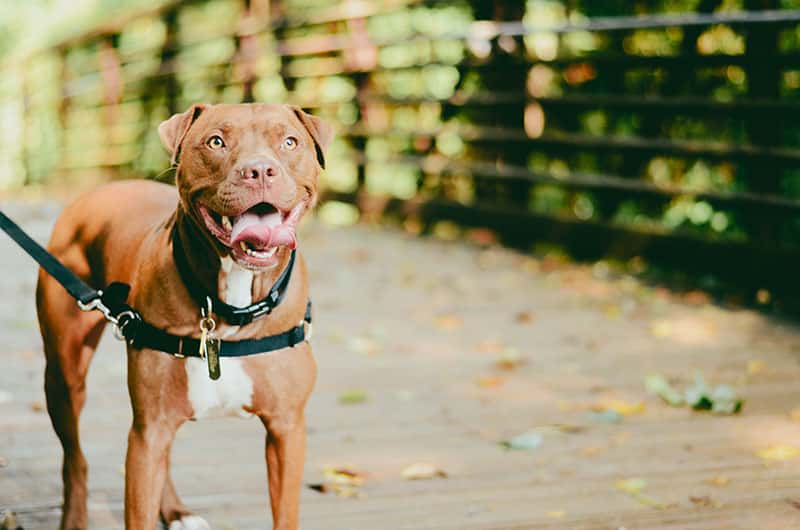
Unfortunately, the Pitbull has a rather terrible history of violence and bloodshed. The breed was first produced in the mid-19th century in England, bred from the Old English Bulldog and a variety of Terrier-type breeds.
The Pitbull first came to prominence as a ‘bull-baiting’ dog and was bred to participate in this ‘sport’. The Pitbull would be released into a field with an angry bull and was run till either the bull collapsed from exhaustion or the Pitbull was killed. Similarly, Pitbulls were also bred to fight other dogs.
In 1835, England passed the Cruelty to Animals Act, which forbade dog-fighting, bull-baiting and a variety of other cruel ‘sport’ involving animals. This led to the Pitbull becoming a companion pet.
How Popular Are Pitbulls in the United States?
Pitbulls are, unfortunately, illegal in most American states and some cities, too. This murky legal status has made Pitbulls a bit of a faux-pas in the U.S., with the breed unrecognised by the American Kennel Club.
This has meant that popularity statistics are difficult to come by, though other websites have curated ownership stats, which state that Pitbulls make up to 20% of the American ‘strong’ dog population.
Who Are Pitbulls a Good Dog For?
Pitbulls are great dogs for those with physical strength. They’re medium-sized dogs in terms of height and weight but are very powerful animals that are well-built and tough. Despite this, they are also somewhat gentle dogs and are great for families or single individuals. Though, because of their build, they aren’t suitable for the elderly.
How Did Pitbulls Come About?
Pitbulls were originally bred in England in the mid-19th century as fighting dogs. And often participated in ‘bull-baiting’, dog fighting and were also employed as rat killers in English factories.
When Did We First Cross-Breed The Pitbull?
Given the Pitbull’s murky legal history in the Western world, their ownership is tightly restricted, and thus most people who have Pitbulls tend to have a crossbreed rather than a purebred. It’s highly likely that modern crossbreeding of Pitbulls began sometime between 1990 and the early 2000s, as popularity of crossbreeding surged across the U.S.
How Important Is a Dog’s Temperament to Your Family?
One of the most important aspects of any relationship between you and your dog is how you and your dog’s temperament interact. The same is true of its relationship to your family unit. Getting this right and ensuring that temperaments don’t clash is critical to pet ownership.
It would be best if you did adequate research on the possible temperaments of your prospective dog before making arrangements to adopt or purchase the animal. Doing this research will mitigate any surprises and get you and your family better prepared to welcome onboard a new member.
Failure to do so could result in you having to re-home the dog, which causes more trauma and pain for everyone involved.
What is the Temperament of the Pomeranian Pitbull Mix?
The Pomeranian and Pitbull temperaments are slightly at odds with one another. The Pomeranian tends to be a little more subdued, whereas the Pitbull is an excitable bundle of energy. When mixed, the Pomeranian Pitbull temperament tends to be calm while maintaining some of the energy of the Pitbull. The dog will also be vigilant and intelligent.
Is The Pomeranian Pitbull Mix Friendly?
Yes! You will find that the Pomeranian Pitbull mix is a very friendly mixed-breed dog.
Is The Pomeranian Pitbull Mix Easy to Train?
While the Pitbull is a bundle of energy, the Pomeranian is a slightly less energetic dog, giving you a nice, even-tempered mix that both listens and is quite intelligent, allowing it to grasp training concepts quickly and follow commands.
How Much Can A Pomeranian Pitbull Mix Weigh?
The Pomeranian Pitbull mix weighs between 7 and 24 pounds.
How Tall Can A Pomeranian Pitbull Mix Get?
The average height of the Pomeranian Pitbull mix is between 8 and 18 inches.
Similar Sized Breeds
There are a few similar-sized breeds to the Pomeranian Pitbull mix. These include: the Lakeland Terrier, the Shetland Sheepdog, the Chow Chow and the Border Collie.
Does the Pomeranian Pitbull Mix Shed?
You can expect a moderate amount of shedding from the Pomeranian Pitbull mix – a weekly brush should be sufficient to keep the shedding at bay.
How Much Exercise Does A Pomeranian Pitbull Mix Require?
You should expect to walk your Pomeranian Pitbull mix for between 30 and 45 minutes daily.
How Long Can a Pomeranian Pitbull Mix Live?
The average lifespan of a Pomeranian Pitbull Mix is between 12 and 16 years.
What Health Conditions Could the Pomeranian Pitbull Mix Have?
- Patellar Luxation (kneecap dislocation)
- Hypothyroidism (thyroid issues)
- Cerebellar Ataxia (motion disorder)
How Can You Find a Pomeranian Pitbull Mix Puppy For Sale?
Finding a Pomeranian Pitbull mix puppy for sale can be a tall order! Before you consider buying a Pomeranian Pitbull mix puppy, consider adoption instead. Adopting can be done by searching your local vet clinic or animal shelter for a Pomeranian Pitbull Mix puppy up for adoption.
If you cannot find a Pomeranian Pitbull mix puppy in either location, you should check out AdoptAPet.com to find dogs in your area up for adoption.
How Much Does a Pomeranian Pitbull Mix Puppy Cost?
If you do decide to buy a Pomeranian Pitbull mix puppy, you should expect to pay somewhere been $500 and $1000 – another reason to consider adoption instead.
Before you go through with the buying process of a Pomeranian Pitbull mix, be sure you read and follow the American Kennel Club’s guidelines on finding and working with reputable breeders.
Is the Pomeranian Pitbull Mix the Right Breed For You?
The Pomeranian Pitbull mix is a fantastic option for those looking for a cute, energetic companion dog that’s even-tempered, with the Pomeranian and Pitbull having complementary temperaments. Whether you’re a family unit, couple, or a single individual, the Pomeranian Pitbull mix might just be the dog for you!

